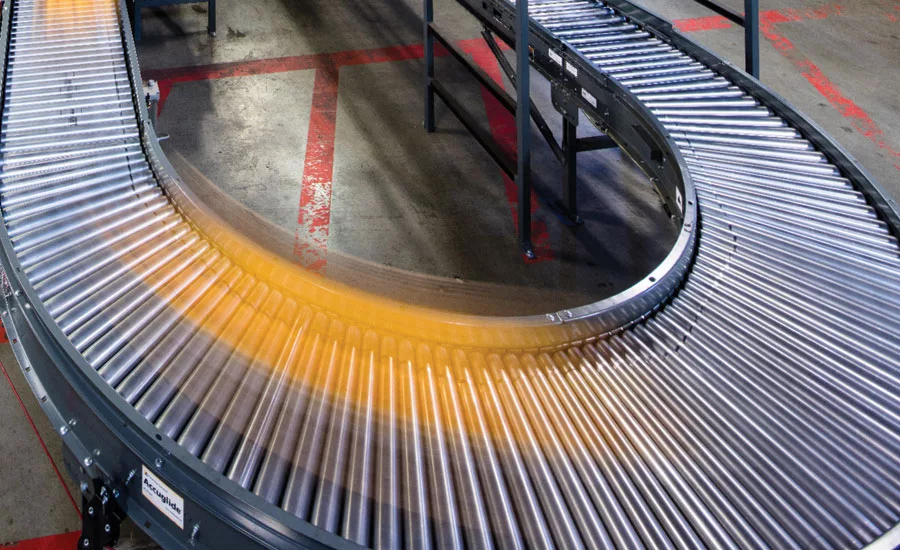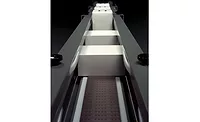Conveyors accommodate diverse container shapes, materials
Non-roller conveyors, spiral-lift conveyors among options offered

Smaller primary containers and secondary packages, lightweighting and moving bulkier 36-packs are impacting conveyor systems, experts say. (Image courtesy of Honeywell Intelligrated)
The 1978 rock anthem “Roll with the Changes” by REO Speedwagon suggests that one has “got to, got to, got to keep on rollin’” with the changes to stay positive and be successful. Although not sung about beverage warehouses, more SKUs, smaller batches and more frequent changeovers have impacted conveyor systems, which literally have had to “roll with the changes.”
Tom Eure, director of material handling at Beloit, Wis.-based Regal Beloit America Inc., notes that the variation of container shapes and diverse designs are significantly impacting conveying operations. “Historically, a plant would run one or two bottle or container designs; now they’re running many different shapes and sizes,” he explains. “System manufacturers are designing more flexible and dynamic conveyor systems, addressing the need for quicker changeovers and offering rail adjustments that can be made quickly and easily repeatable (either manually or automated).
“With some solutions, a touch of a button allows guiderail systems to go from moving small bottles or containers in the morning to larger bottles or containers in the afternoon,” Eure continues. “Regal is currently working with a major brewer that is installing conveyor systems that will run cans and bottles on the same line, and we expect to see more of this.”
Beverage producers are “sizing for convenience” and the shift to smaller primary containers and secondary packages of 8-ounce vs. 12-ounce containers and four- or eight-count packaging has driven the need for production line conveyors that can accommodate traditional pack sizes and diverse packs, says Bryan Boyce, product marketing manager at Honeywell Intelligrated, Mason, Ohio.
“At the warehouse level, dealing with packaging that ranges from large packs for club stores to small packs for convenience stores on the same conveyors systems creates challenges in controlling package movement on the same line,” Boyce says.
Conveyor systems are responding to this trend by integrating powered transition belts or using spiral lift conveyors rather than straight line conveyors. “Transitional gaps between conveyors are bridged with powered belts to ensure packages do not stall, skew or jam,” Boyce explains. “Spiral lift conveyors maintain package integrity with a gradual elevation change in a smaller footprint. They can also implement low-back-pressure accumulation conveyor styles … with a modular belt conveyor working well for accumulation of pad-less, shrink-only packaging.
“These non-traditional, non-roller conveyors provide smooth normal conveyance at an acceptable level of accumulation without package degradation,” he continues. “On existing systems, implementing multi-position conveyor side guides is a common way of adapting to new packaging, especially for introducing smaller packages as they can easily become skewed or rotate during conveyance.”
The accumulation equation
Lightweighting of plastic water bottles and aluminum cans also has had a huge impact on conveyor systems because fragile packaging easily can be dented or damaged. As a result, new conveyor system designs should take into account the point on a conveyor where products accumulate and how the guide rail will impact delicate packages, Regal Beloit’s Eure says.
Larger, heavier packs, such as those offered in 36-pack configurations, mean that a conveyor has to be more robust to handle the increased weights of heavier, bulkier packaging, he adds.
Regal Beloit offers a Combi-System, which combines the blow molder, filler and caper in one machine, taking up one-third of the space while eliminating the need for air conveyors in plastic bottles. Another next-level solution, the System Plast NG Evo, features a dry-running conveyor system that uses an advanced, low-friction, FDA-approved chain for running conveyors for beverage applications.
“The System Plast NG Evo helped save Sierra Nevada nearly 1 million gallons a water within a year of installing a dry-running conveyor system,” Eure says.
Honeywell Intelligrated’s product portfolio includes both traditional roller-based conveyors and a full line of conveyors that use modular plastic belts. All conveyor systems are customized to meet clients’ needs, Boyce says.
Depending on product mix and operational requirements, the company offers various carton accumulation conveyors such as the Accumat rollerless conveyor, the roller-based Accuglide, EZ Set and IntelliQ products. For zone control, the ZoneFlex Advanced, a roller-accumulation conveyor, maximizes operational efficiency and provides gentler carton control, according to Boyce.
Experts note that designing and building a conveyor system can be tricky. “Beverage-makers and distributors should consider throughput, the product being handled and how fast it has to move,” Regal Beloit’s Eure says. “There is not a one-size-fits-all solution in the marketplace today.” BI
Looking for a reprint of this article?
From high-res PDFs to custom plaques, order your copy today!





